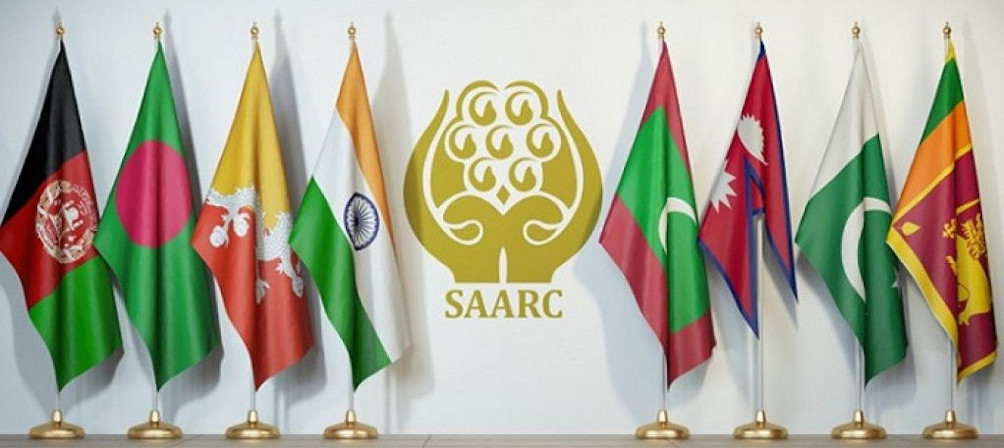24 March, 2020

The South Asian Association of Regional Cooperation (SAARC) was conceived in 1985 and it marks the geopolitical grouping of eight countries of South Asia- Afghanistan, Bangladesh, Bhutan, India, Nepal, Maldives, Pakistan and Sri Lanka. According to the World Bank, the South Asian nations are facing the worst crisis recorded in the past forty years. South Asia has emerged as one of the epicentres of the virus today. With India leading the herd, a tweet by Prime Minister Narendra Modi ‘to chalk out a common strategy to fight the Coronavirus’ called for a virtual meeting of all SAARC leaders on March 15, 2020. New Delhi’s approach towards the regional bloc not only resonates with India’s leadership ambitions but is also in accordance with its Neighbourhood First Policy.
India’s relations with the SAARC were for long frozen with PM Modi declining the Islamabad summit in the aftermath of the 2016 Uri attack. Citing instances of cross-border terrorist activities carried out by Pakistan in the long-disputed periphery, the future of the SAARC seemed to be uncertain. With the tentacles of the virus embedded worldwide, the realisation of multilateral cooperation dawned on South Asia that responded to Modi’s call with great fervour. The South-Asian region is determined by highly porous borders and extremely dense population which explicitly shows that mere national effort will not be effective to combat the threat. The pandemic made it clear that regional consolidation and multilateral cooperation is the way forward.
New Delhi’s proposal for a virtual summit culminated into a video conference of the head of the governments of the eight member-states except for Pakistan. Pakistan’s Prime Minister very efficiently evaded the conference and instead appointed the Special advisor on Health, Zafar Mirza to fill the void. One of the fundamental outcomes of the summit was the institution of a joint SAARC Emergency Relief Fund to which India pledged US $
A fundamental utility of the Emergency Fund is to strengthen the health sector of the SAARC nations until a vaccine to effectively combat the virus is developed. Even otherwise, SAARC countries have come up with respective relief packages aimed at the welfare of their people. India, being the biggest among the eight-member group with its US $
SAARC had been a dormant volcano since the 2014 Kathmandu summit, leaving the question of South-Asian regional cooperation in jeopardy. The significance of the virtual summit lies in the fact that it exacerbates PM Modi’s most favourite activity- personal diplomacy and enhances India’s scope of a South-Asian leadership. Moreover, India’s inclination to cooperate with recalcitrant neighbours such as Pakistan highlights the country’s attitude towards rising above cross-border animosities and thinking in terms of a collective preventive strategy. The summit explicitly stated regional integration and multilateral cooperation as a desideratum. The question now is- Is SAARC 2.0 the way forward?
The global threat that has wreaked havoc across geographies has perhaps established the right time for the revival of the SAARC. New Delhi’s initiative towards the resurrection of the SAARC is a boost to the country’s position at the centre of regional dynamics. India’s willingness to play the COVID card by creating an emergency fund or proposing and implementing measures to control the pandemic is an indication of New Delhi’s deep South-Asian ambitions.
In its 35 years of existence, the SAARC can very well be referred to as a failed case. The bloc was fed with challenges with New Delhi turning its back to the SAARC and instead shifting its focus towards strengthening the Bay of Bengal Initiative for Multi-Sectoral Technical and Economic Cooperation (BIMSTEC). Moreover, in the wake of perpetual animosities between India and her neighbours, regional integration at a multilateral level seemed uncertain. However, following the virtual meet between the member states, certain things can be put into perspective. Firstly, SAARC nations have realised that a global pandemic cannot be frustrated through mere national efforts, which is why the other members responded with alacrity to India’s proposal of an e-summit. Secondly, India played its masterstroke by alienating bilateral tensions with Pakistan and ignoring Pakistani questions on the Kashmir issue at a conference aimed at taking up more pertinent issues. The ball is now in India’s court who has managed to garner massive praise from the US and Russia for its tactical dealing and working towards the regional good of South Asia. Thirdly, India’s contribution of a US $
Conclusion:
Due to its geographical position, India enjoys certain leverage in South Asia. However, the fatal impact of a global crisis has propelled the SAARC nation states to think in terms of cooperation and use the bloc as a tool to foster regional integration. It is known for a fact to South-Asian countries that a collective effort will lead them to a success story in combating the unprecedented threat. It may act as a mechanism to develop vital bilateral ties, create mutual cooperation and understanding among nation-states, strengthen regional cooperation and defeat the virus. Failure of the US or EU in the face of the pandemic and negative global attention towards China (which traces to the release of the virus from its wet market at Wuhan) has, for a fact, paved the way for a multilateral future. How the bloc revives itself by using the pandemic as a catalyst and returns with a stronger and more able SAARC 2.0 is yet to be seen.
The views expressed above belong to the author.
Image Source
Other Research Articles
Pending Reforms Pose Continued Challenges for Renewable Energy Projects
March 25, 2024
BRI in Nepal: Issues and Challenges
March 18, 2024
France’s Indo-Pacific and Indian Ocean Regional Strategy Draws Closer to SL
February 28, 2024
The Diplomatic Impasse of Indo-Canadian Relations: A Moment to Retrospect
October 15, 2023